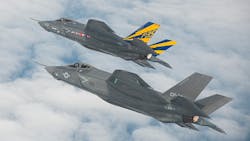Pratt & Whitney Faulted as Biggest F-35 Engine Deal's Cost Rises
United Technologies Corp.’s Pratt and Whitney unit has been slow to incorporate promised cost savings techniques for the latest and biggest batch of engines to power F-35 jets, the Pentagon’s costliest weapons program, according to a new report.
Pratt is producing 102 engines for the fighters built by Lockheed Martin Corp. under what’s now a $2.1 billion contract, including management, engineering support and spare parts. When it was signed in July 2016, Lieutenant General Christopher Bogdan, who headed the Defense Department’s F-35 office, said Pratt’s team “has kept their word in delivering on their price reduction commitments.”
One year later, the F-35 office took a different view in its annual Selected Acquisition Report on the program’s progress. It reviewed the schedule and cost status from July 2016 to April of this year, disclosing estimates of $43 million in cumulative cost overruns for materials, which Pratt & Whitney will have to absorb if they persist.
Engine hardware “is costing more than planned,” according to the report, primarily because the contractor’s targets aren’t “achievable today due to delays with incorporating enough engineering changes and affordability initiatives to lower the manufacturing costs,” according to the document obtained by Bloomberg News.
Supply Chain Challenges
Pratt & Whitney’s supply chain team also has “been unable to negotiate lower pricing from the supply chain,” the F-35 office added.
Through April, the engine maker was behind on $51 million in work due to late engine hardware deliveries, some quality lapses with engine nozzle parts and other supplier issues, according to the report.
Controlling costs is crucial as the Pentagon plans to increase its budget requests to 77 engines in fiscal 2019 from 74 this year. The number would jump to 99 by 2022. The Pentagon’s annual engine procurement requests are planned to increase to $2 billion by 2022 from $1.6 billion this year.
Pratt & Whitney spokesman Matthew Bates deferred comment on the cost report to the Pentagon. In general, since 2009 when Pratt launched its “War on Cost,” the company has reduced F-35 engine costs “by more than half,” Bates said in an email.
“We continue to focus on implementing engineering design changes and working with our supply chain to further reduce costs, and we expect further cost reduction as the volume from the engine production ramp increases,” Bates said.
Contractor’s Responsibility
Although the report “shows engine hardware is costing more than the contractor planned, those additional costs are not being passed on to taxpayers,” F-35 program office spokesman Joe DellaVedova said in an email. “If Pratt & Whitney falls short on their commitments, the company accepts full responsibility for cost overruns” under its fixed price, incentive fee contract.
The Government Accountability Office said this year in its annual F-35 report that “manufacturing efficiency and quality metrics are improving for Pratt & Whitney. Although some engine aircraft reliability and maintainability metrics are not meeting program expectations, there has been progress in some areas, and there is still time for further improvements.”
The $51 million overrun caused by lagging work is likely to disappear when the contract is completed, DellaVedova said. “Although Pratt & Whitney and its supply chain is delivering late items to their original plan, there is schedule margin and engine deliveries continue to support aircraft requirement dates,” he said.
Even with the troubling early overruns engine cost targets are going down with each successive contract, DellaVedova said.
By Tony Capaccio
About the Author
Bloomberg
Licensed content from Bloomberg, copyright 2016.
